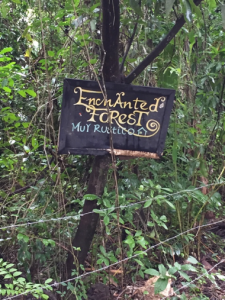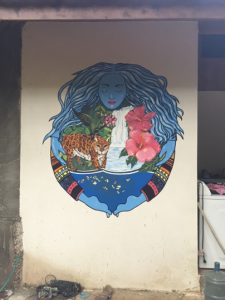Costa Rica is a country well known by Americans as a destination for beach vacations, surf tourism, and mission trips. It is also widely considered to be a global model of sustainable development: an eco-paradise, complete with pristine beaches and well-preserved rainforests teeming with diverse wildlife. Yet a visit to the Pacific coastal town of Jacó, one of the communities I visited in July with a UGA class, reveals a different side of the country: a jumble of souvenir stores, surf shops stocked primarily with clothing, American-owned stores specializing in yoga paraphernalia or vegan ice cream, and nocturnal indulgence in drugs and prostitution. Costa Rica is a country with two faces that uneasily coexist under the slogan “Pura Vida,” a phrase which can be found simultaneously on the cheesiest souvenir T-shirts and in the most genuine sentiments of its citizens. To see how Costa Rica got this way and where it may go, it is essential to understand its complex relationship with conservation, development, globalization, and the United States.
Sixty years ago, the coasts of Costa Rica were lined with fishing communities and the interior replete with cattle ranches. Today the government owns all land within 50 meters of the high tide line, fishing is heavily restricted and more than a quarter of the country’s territory is protected in national parks or forest reserves.((Honey, Martha. Ecotourism and Sustainable Development: Who Owns Paradise? Island Press, 1998.)) Conservation in Costa Rica was anchored by the establishment of protected areas by Mario Boza, the founder of the country’s first Department of National Parks, and his associates beginning in the late 1960s. By 1993, the national park system protected 12.2% of Costa Rica’s land and contained “205 species of mammals, 845 species of birds…approximately 10,000 species of vascular plants…that account for nearly 4% of the total number of plant species in the world”.((Boza, Mario A. “Conservation in Action: Past, Present, and Future of the National Park System of Costa Rica.” Conservation Biology, vol. 7, no. 2, June 1993.)) As global fads in conservation have changed, Costa Rica has remained a pioneer, employing trendy strategies such as debt-for-nature swaps (in which a creditor nation forgives a portion of the debtor nation’s external debt in exchange for conservation projects), fee-for-environmental-service policies (in which private landowners are paid to manage their holdings responsibly), and the conversion into ecotourism sites of locales that previously relied on resource extraction. The country also integrates lessons about ecology and environmentalism into its education system at all levels, contributing to a national culture of ecology.

These efforts have earned Costa Rica considerable attention from the international scientific, conservation, and surfing communities. One growing phenomenon is the previously mentioned “ecotourism” – a form of environmentally conscious tourism that seeks to combine the sublime experience of nature tourism with responsible lifestyle and consumption practices. The theory underlying the growth of ecotourism portrays it as a “win-win”: a source of income that relies on nature’s beauty rather than its exploitation, and therefore aligns public economic interests with the preservation of the natural environment. The statistics, as well as my own experience of speaking to people up and down the Pacific coast of Costa Rica, bear out this narrative to a considerable extent. According to Dr. Martha Honey of the Center for Responsible Travel, tourism accounts for 7 to 8 percent of Costa Rica’s GDP.((Honey, Martha. Ecotourism and Sustainable Development: Who Owns Paradise? Island Press, 1998.)) This brings an influx of foreign capital to hotels, shops, restaurants, and national parks, all of which employ Costa Rican workers and some of which are run by them. Of these tourists, Dr. Robert Fletcher of the University of Florida writes, “at least 60 per cent of international arrivals are attracted by the national parks and other environmental attractions”.((Fletcher, Robert. “Between the cattle and the deep blue sea: The Janus face of the ecotourism-extraction nexus in Costa Rica.” Proof, 2013.)) Ecotourism, at least at surface level, seems to be a model example of a good incentive within a capitalist framework; economic self-interest and ethical behavior have been forced into alignment.4
The environmental and spiritual reputation of Costa Rica has transformed the identity of the country. Honey writes, “There’s a lexicon of environmentalism here, right up to the president.” Foreigners have flocked to Costa Rica for years, expanding a network of primarily American expatriates and visitors. One significant group is the scientific community focused on biological and ecological research, including UGA’s own Dr. James Porter. Another community, which coexists uneasily with the scientists, finds itself at the nexus of environmental activism, anti-materialism, and “soul surfer” culture. The national ethos of Costa Rica attracts surfers, photographers, tattoo artists, and others who become involved in local life by opening surf shops or hotels. There is a body of literature, anchored by the work of Dr. Krista Comer of Rice University, on the expansion of California soul surfer culture to Costa Rica and other locales that are perceived as freer from the commodification, capitalist values and stifling social atmosphere of the United States.((Comer, Krista. Surfer Girls in the New World Order. Duke University Press, 2010.)) This Central American country promises a more “authentic” spirit of rebellion, simple living, and a slow pace of life. These immigrants have brought along lifestyle elements like yoga and vegetarianism that are becoming stronger forces on the coasts.

Beneath the veneer of eco-paradise, however, Costa Rica is experiencing a host of complicated problems, many of which are intimately tied to its greatest strengths and successes. One of these is the hijacking of national development policies by large fruit corporations and hotel interests. For example, Dr. J. Robert Hunter of the Tropical Science Center notes that the U.S. Army Corps of Engineers built infrastructure in northeastern Costa Rica that mostly benefitted large banana corporations. According to Hunter, “the fruit companies had been given tax breaks and other incentives, including permission to deforest an enormous area to plant bananas, while obviating a number of laws”.((Hunter, J. Robert. “Is Costa Rica Truly Conservation-Minded?” Conservation Biology, vol. 8, no. 2, June 1994.)) He further found that most of the workers involved were illegal Nicaraguan immigrants. The widespread use of illegal Nicaraguan labor was universally confirmed by people I spoke to in Costa Rica as well; these immigrants are underpaid and subjected to poor work conditions because they have no legal recourse. The most desirable coastal land beyond the 50-meter line that signifies public property – although this law is not always obeyed – tends to be foreign-owned. By the early 1990s eighty percent of beachfront property was owned by foreigners, and today 57 percent of hotels and resorts are foreign-owned, while foreign-owned resorts are built on the most desirable beaches.1 A few hotel companies, such as Marriott and the Four Seasons, have built gargantuan coastal tourist enclaves within gated communities. From those two hotels, one can easily see the ocean and the mountains, but no actual human communities. This is not an accident, but rather a deliberate attempt to conceal ordinary Costa Rican life from foreigners who expect an idyllic vacation.
Other problems accompany the arrival of immigrants and tourists – even those who strive to be conscious of their own environmental and cultural impact. Ecotourism exhibits many of the same problems as conventional tourism, such as the creation of a dependent economic relationship wherein troubles or changes in the U.S. economy can harm Costa Rica as well. This did in fact happen in the aftermath of the 2008 U.S. financial crash, as tourism and new investment both dried up significantly. This has led to fears that certain areas depend on tourism as a “monocrop,” for example in Monteverde where “65 to 70 percent of the area’s income now comes from tourism”.((Honey, Martha. Ecotourism and Sustainable Development: Who Owns Paradise? Island Press, 1998.)) Another issue is the conversion of coastal places into tourist towns. Champion surfer Gustavo Castillo was one of the many people I met who lamented (with old photos) the transformation of a beautiful beach into a trashy tourist town. In fact, not a single Costa Rican native to whom I spoke expressed a favorable opinion of the growth of Jacó or the level of development happening on the coast in general.

This development, unfortunately, is made almost inevitable by continued immigration, tourism, and the logic that drives capitalist markets. Tourists and immigrants drawn to Costa Rica – frequently because they see it as close with nature, rustic, and culturally appealing – drive the expansion of amenities and consumer products that cater to them, whether those be souvenir shops, surf shops, vegan ice cream shops, or even merely a larger source of running water. Travelers seeking undisturbed landscapes are frequently the ones who disturb these landscapes; surf journalist Steve Barilotti writes, “as they travel to isolated places, they carry the frontier of development forward”.((Barilotti, Steve. “Lost Horizons: Surf Colonialism in the 21st Century.” The Surfer’s Journal, vol. 11, no. 3, Summer 2002.)) Foreigners “vote” for development with their cash, and their presence increases the pressure toward the use of English in conversation and signage. There is no market mechanism for countering development, because the much greater wealth of tourists would render the abstention of locals irrelevant even if such a movement could be organized. The idealistic image of paradise projected by Costa Rica – and supported by the government, local citizens, developers, and environmentalists for various different reasons – serves to conceal some of these realities on the ground: namely that the culture, lifestyle, natural environment, and economic diversity of Costa Rica may be in danger. Without a significant, highly improbable overhaul of the market system, it is difficult to see how an arrangement so lucrative for developers and the budding service industry could change in the near future.
